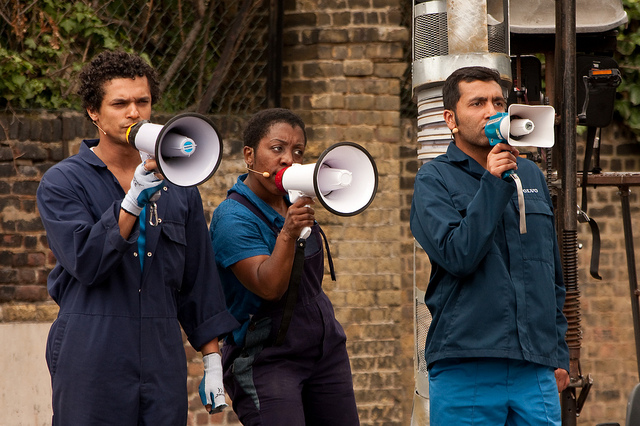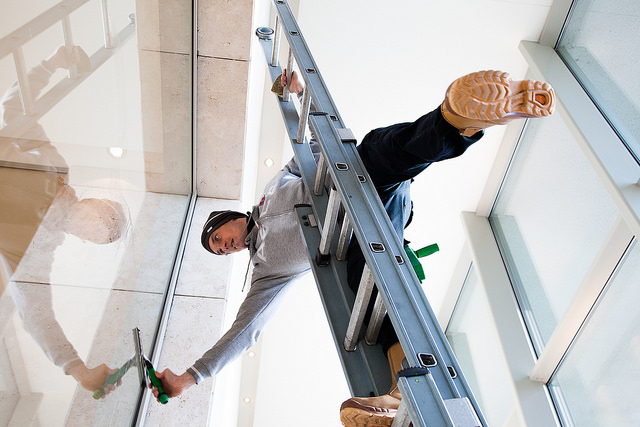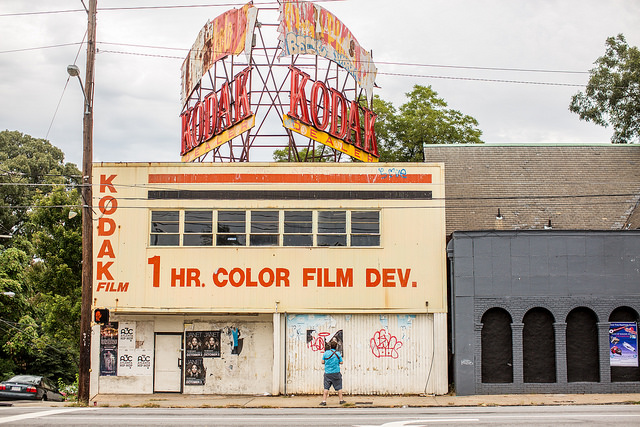Unlock the Magic in Your Story Now
Get the Free 20 questions to Ask Before Launching Your Idea workbook when you sign up for occasional updates.
Get the Free 20 questions to Ask Before Launching Your Idea workbook when you sign up for occasional updates.
Signalling
filed in Marketing, Story Skills, Storytelling

According to the Collins English Dictionary, a signal ‘is a gesture, sound, or action which is intended to give a particular message to the person who sees or hears it.’
We are sending signals to our clients and customers whenever they come into contact with our business or brand—even when we’re not face-to-face. Words, images, dress, titles, tone, body language, location, prices, packaging, decor and design give people clues about who we are, what we stand for and what we’re worth. The flipside is that when we allocate resources, we’re also sending a signal to ourselves about what we’re worthy of.
Customers are making decisions based on our signals, so it pays to be intentional about every signal we send. When I get an email, like the one I got yesterday from an insurance company assuring me that my query is important to them ‘and will be replied to within three business days,’ I’m forming an opinion about what it would be like to be a paying customer with an urgent request.
Of course, in the days of online customer reviews, we can’t always control the message—which is all the more reason to make sure that the story we tell when we can is sending the signal we intended to send.
Image by Garry Knight
Share this article
What The Best Communicators Do
filed in Marketing, Story Skills, Storytelling

Professor Daniel Kahneman has spent a lifetime researching why and how humans make decisions. His decades of work focused on the two ways we think and decide using one of two modes of thought, System 1 and System 2. System 1 makes fast, instinctive and emotional judgements and System 2 operates at a slower more logical level. Kahneman wrote a five hundred page book on the subject titled Thinking Fast and Slow.
Of course, just like us, even Nobel prizewinning researchers don’t usually have a lifetime or five hundred pages to explain the impact of their work. We often only have someone’s attention for seconds, let alone minutes. The mistake we make as communicators, marketers and salespeople is believing that we need to give people all the information while we have their attention—that’s what we were taught at school. We were not penalised for writing down everything we knew in an exam. The best way to win at exams was to write down everything we knew. But this doesn’t work when we’re face-to-face with people.
The goal isn’t just to deliver the information—it’s to capture the imagination. This is how we communicated as children—in stories, not facts. But over the years we’ve unlearned all of that. If we’re serious about making an impact, we need to start reclaiming those innate storytelling skills we once had.
When Professor Kahneman describes how System 1 works, he tells the story about calling his wife Anne on the phone and knowing immediately what kind of mood she’s in just by hearing her tone of voice when she picks up. Whenever he tells that story, the audience laughs, they nod their heads, they immediately get it.
The next time you’re asked a question about what you do or why it works, don’t go into a long explanation. Just start with the words, ‘let me tell you a story’.
Image by Garry Knight
Share this article
The Immeasurable Benefits Of The Immeasurable
filed in Storytelling, Strategy, Success

Joanne has no idea what the return on investment of sweeping her bakery floor is. And yet she does it first thing each morning before the first customer arrives.
Harry has no way of knowing if the three hours he spends cleaning his taxi inside and out at the weekend makes a difference to passengers. But he makes the effort all the same.
Sean will never meet the diners who sit admiring the view from the restaurant windows he cleans. That doesn’t stop him polishing out every single smudge and smear.
We underestimate the value of the things we cannot quantify or track—not only to our customers, colleagues or companies but for the joy and fulfilment they bring us in the doing of them. The way we do the work, not just the work itself, is how we own our story.
Image by Udo Geisler
Share this article
Building A Following

We’re seduced by the idea that followings and fortunes are made by hastily increasing our visibility on the platform of the day. The truth is the people and brands who earn our attention patiently built their following over time.
It’s the work we quietly get on with when no one is watching that makes people care to connect. Visibility alone won’t get us to where we want to go.
Image by Garry Knight
Share this article
We Value What We Measure
filed in Storytelling, Strategy

One of my first jobs was working as the manager of a little Dublin cafe that stood at the intersection of two busy city streets. It was a lot of responsibility for someone in their late teens, and I loved it. There was something magical about opening the shutters first thing in the morning when it was still dark, then putting the lights and the coffee on, ready to welcome the first customers.
We saw the same faces every day. Office workers who grabbed a quick cuppa and a pastry on their way to work, builders who ordered soup or sandwiches for lunch. University students who nursed a cup of tea for hours while they read over their lecture notes in the afternoon.
It was a privilege to become part of customers’ rituals—to be welcomed into their life. We didn’t just exchange money for beverages and convenient snacks. We got to know people. We nourished them and became part of their story.
Our little cafe was the first branch in a chain of cafes, each with its own character and unique location. New branches opened each year. Oliver, the owner, did the rounds of them all. He visited us twice a day. During the lunchtime rush—to gauge the extent of the rush. And at the end of the day to count how much money was in the till. If the takings were up, he was happy. If they were down, his face grew dark, and he began to question why. As Oliver’s empire expanded the money consumed him. He found it hard to see past the coins and bills he could count at the end of the day and even more difficult to connect those totals with an ongoing business strategy. He grew less optimistic about succeeding and more worried about failing with every new branch he opened. Oliver became fearfully reactive to the marketplace instead of bravely responsive to our customers.
He began to cut corners and compromising on quality, ordering food from cheaper suppliers and hiring less staff. He raised prices without giving customers, who were now paying more for an inferior product and service, any notice or a reason. Soon the takings grew smaller as the lines thinned out and business slowed. The staff who had once loved working there left, as day-by-day our little gem of a cafe lost a bit more of its soul.
In a world where data is king, it’s more important than ever to remember that what we measure becomes the thing we’re compelled to act on. There’s nothing wrong with tracking our progress—it’s essential to help us decide on our ongoing strategy. But it’s important to look at progress from every angle, not just the most obvious and easiest one to measure.
Image by William Murphy
Share this article
Disruption is…
filed in Strategy

The path to building a successful, sustainable business is littered with innovative ideas, requiring brave leadership to prioritise the needs of tomorrow’s customer above today’s bottom line.
Disruption is having the courage to take the customer where they want to go.
Image by Thomas Hawk
Share this article
Worthy Of Your Marketing
filed in Marketing, Storytelling

When we’re planning a party, we know its success depends on the preparation we do in advance, often before the invitations are sent. Every detail, from the food to the table settings, the lighting to the music is carefully choreographed in anticipation of the guests’ arrival.
When we’re marketing, especially when we’re marketing online, we do the opposite. We spend the majority of our time working out how to get people to the party (our website, podcast or blog), and not enough time giving them a reason to stay once they get there.
The products, services and online experience you’re crafting for your customers need to be worthy of your marketing. Throw a party that’s worth coming to.
Image by gomagoti
Share this article
Meaning At Work

There is an element of the mundane in every job. Consider the cabin crew who work on long-haul flights. The majority of their work is the repetitive, and strenuous task of wheeling trolleys full of food and drink down narrow aircraft aisles while repeating the same script, ‘chicken or beef’, to the three hundred passengers on board. Many people who choose these roles do so because they tell themselves a story about travel perks and seeing the world. It’s unlikely that they spend much time thinking about how boring handing out bottled water, blankets and sick bags will become. The day-to-day reality of this work could provide an ideal environment for breeding discontent and misery.
If that’s so, why do some people thrive in these jobs, while others become disillusioned? It’s likely that the difference between the people who find joy in the work and those who don’t, have found a way to feel like they’re making a difference. The joyful cabin crew find ways to bring more of who they are to their role. They look for opportunities to gain fulfilment from what they say and do at times when they can go ‘off script’. Like the cabin crew on a recent BA flight who tried to help me make my tight connection (I didn’t), by moving me to the front of the aircraft to disembark. And the stewardess who found me a pair of airline pyjamas to change into just in case I missed the flight and got stuck in the airport (I did), or the hostess in the airline lounge who made me dinner, even though everything had been cleaned and packed away for the night.
It isn’t only our clients and customers who benefit when we bring more humanity to work. The more meaning we can find in our work by being who we are, the more we stand to gain.
Image by Austrian Airlines
Share this article
The Loyalty Department
filed in Storytelling, Strategy

My mum, (who is in her late seventies) wanted to negotiate the renewal of her internet and phone contract. She dialled the customer support number listed on her bill and was placed on hold for 30 minutes. When she finally got through to a human being, she was transferred to the ‘loyalty department’. She waited on hold for a further 40 minutes before being connected to someone who could help her. The duration of the call was 1 hour 37 minutes and 26 seconds.
This company and other internet service providers are competing on price. Customers see new, cheaper service bundles advertised and are tempted to switch because the pain of switching is outweighed by the savings they will make. Customers no longer see the benefit of sticking with the company they’ve previously been loyal to unless that company price matches its competitors—which is inevitably what happens when existing customers pick up the phone. Customers who persist with the unacceptable call wait times get a better deal. If the loyalty department speaks to too many customers who want to renegotiate their contract, that affects the company’s bottom line.
We spend more resources to woo new customers than we do to earn the continued loyalty of the customers we already have. When the quality of what we sell or serve is barely distinguishable from that of our competitors, we must find other ways to differentiate. One of those ways is by being true to our customers and having a ‘loyalty department’ that lives up to its name. Loyalty shouldn’t only benefit the company—it should work both ways.
Image by Mabel Amber
